NVIDIA's GeForce GTX 580: Fermi Refined
by Ryan Smith on November 9, 2010 9:00 AM ESTPower, Temperature, and Noise
Last but not least as always is our look at the power consumption, temperatures, and acoustics of the GTX 580. NVIDIA’s performance improvements were half of the GTX 580 story, and this is the other half.
Starting quickly with voltage, as we only have one card we can’t draw too much from what we know, but there are still some important nuggets. NVIDIA is still using multiple VIDs, so your mileage may vary. What’s clear from the start though is that NVIDIA’s operating voltages compared to the GTX 480 are higher for both idle and load. This is the biggest hint that leakage has been seriously dealt with, as low voltages are a common step to combat leakage. Even with these higher voltages running on a chip similar to GF100, overall power usage is still going to be lower. And on that note, while the voltages have changed the idle clocks have not; idle remains at 50.6MHz for the core.
| GeForce GTX 480/580 Voltages | |||||
| Ref 480 Load | Ref 480 Idle | Ref 580 Load | Ref 580 Idle | ||
| 0.959v | 0.875v | 1.037v | 0.962v | ||
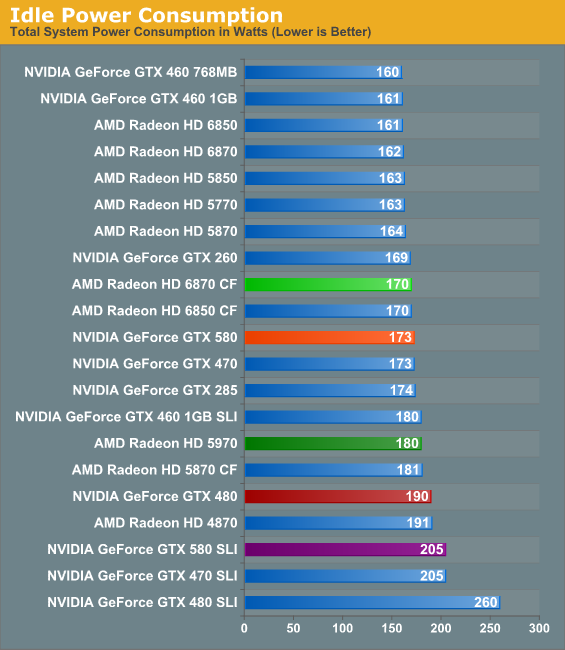
Beginning with idle power, we’re seeing our second biggest sign that NVIDIA has been tweaking things specifically to combat leakage. Idle power consumption has dropped by 17W on our test system even though the idle clocks are the same and the idle voltage higher. NVIDIA doesn’t provide an idle power specification, but based on neighboring cards idle power consumption can’t be far off from 30-35W. Amusingly it still ends up being more than the 6870 CF however, thanks to the combination of AMD’s smaller GPUs and ULPS power saving mode for the slave GPU.
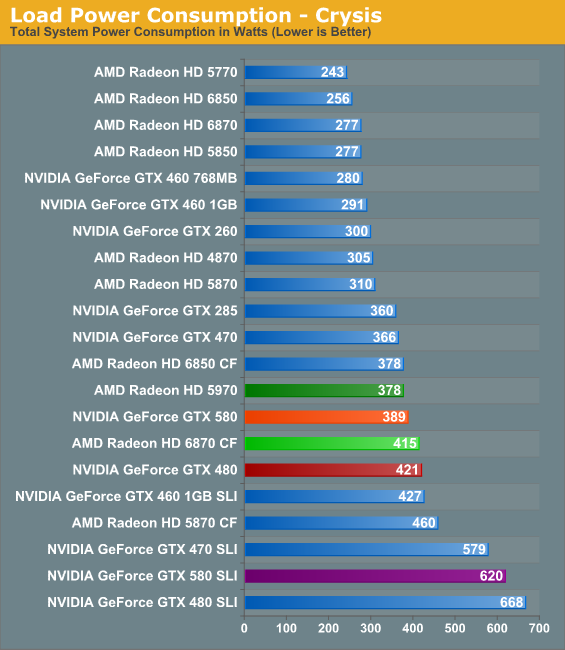
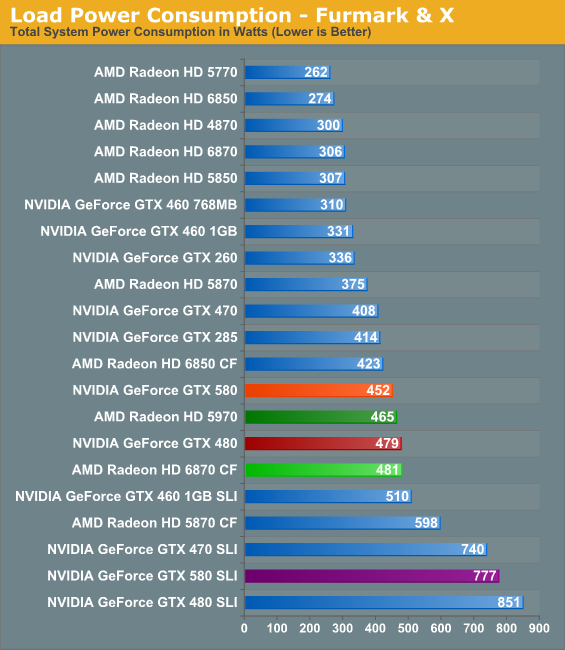
Looking at Crysis, we begin to see the full advantage of NVIDIA’s optimizations and where a single GPU is more advantageous over multiple GPUs. Compared to the GTX 480 NVIDIA’s power consumption is down 10% (never mind the 15% performance improvement), and power consumption comes in under all similar multi-GPU configurations. Interestingly the 5970 still draws less power here, a reminder that we’re still looking at cards near the peak of the PCIe specifications.
As for FurMark, due to NVIDIA’s power throttling we’ve had to get a bit creative. FurMark is throttled to the point where the GTX 580 registers 360W, thanks to a roughly 40% reduction in performance under FurMark. As a result for the GTX 580 we’ve swapped out FurMark for another program that generates a comparable load, Program X. At this point we’re going to decline to name the program, as should NVIDIA throttle it we may be hard pressed to determine if and when this happened.
In any case, under FurMark & X we can see that once again NVIDIA’s power consumption has dropped versus the GTX 480, this time by 27W or around 6%. NVIDIA’s worst case scenario has notably improved, and in the process the GTX 580 is back under the Radeon HD 5970 in terms of power consumption. Thus it goes without saying that while NVIDIA has definitely improved power consumption, the GTX 580 is still a large, power hungry GPU.
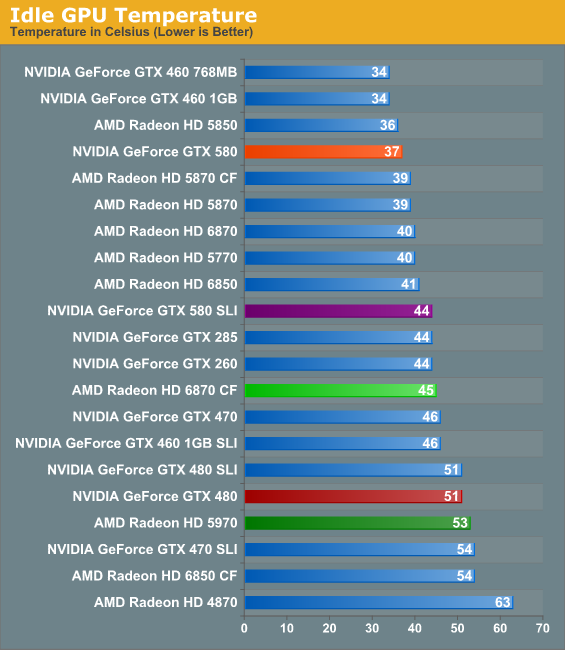
With NVIDIA’s improvements in cooling and in idle power consumption, there’s not a result more dramatic than idle GPU temperatures. The GTX 580 isn’t just cooler, it’s cool period. 37C is one of the best results out of any of our midrange and high-end GPUs, and is a massive departure from the GTX 480 which was at least warm all the time. As we’ll see however, this kind of an idle temperature does come with a small price.
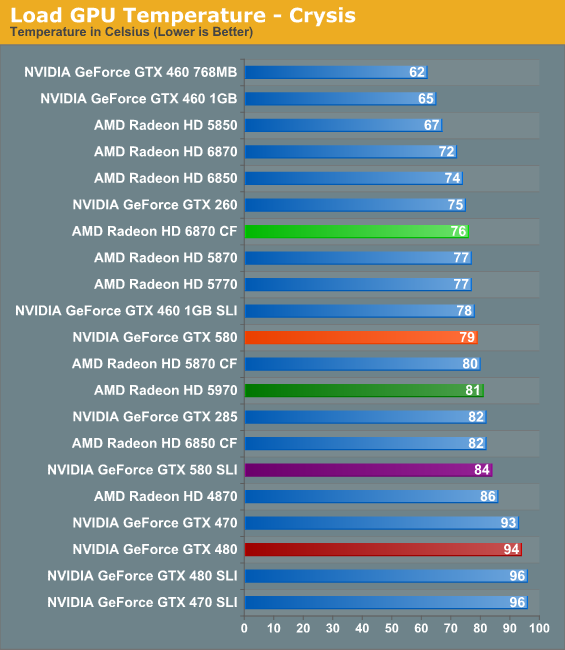
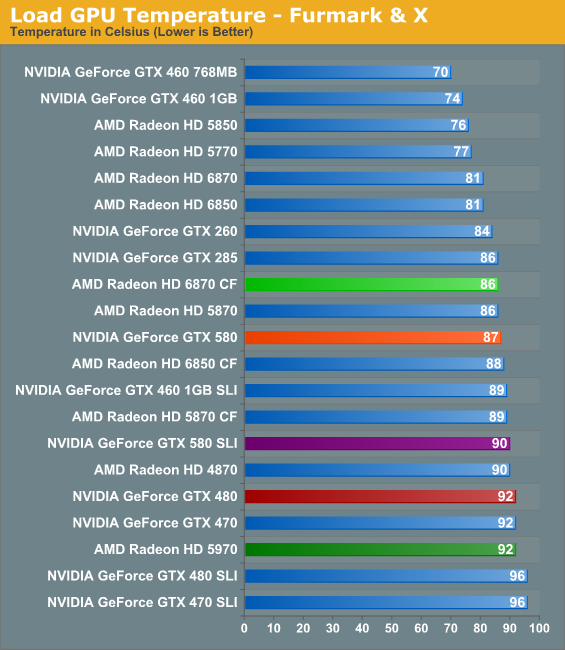
The story under load is much the same as idle: compared to the GTX 480 the GTX 580’s temperatures have dramatically dropped. At 79C it’s in the middle of the pack, beating a number of single and multi GPU setups, and really only losing to mainstream-class GPUs and the 6870 CF. While we’ve always worried about the GTX 480 at its load temperatures, the GTX 580 leaves us with no such concerns.
Meanwhile under FurMark and Program X, the gap has closed, though the GTX 580 remains in the middle of the pack. 87C is certainly toasty, but it’s still well below the thermal threshold and below the point where we’d be worried about it. Interestingly however, the GTX 580 is actually just a bit closer to its thermal threshold than the GTX 480 is; NVIDIA rated the 480 for 105C, while the 580 is rated for 97C. We’d like to say this vindicates our concerns about the GTX 480’s temperatures, but it’s more likely that this is a result of the transistors NVIDIA is using.
It’s also worth noting that NVIDIA seems to have done away with the delayed fan ramp-up found on the GTX 480. The fan ramping on the GTX 580 is as near as we can tell much more traditional, with the fan immediately ramping up with higher temperatures. For the purposes of our tests, this keeps the temperatures from spiking as badly.
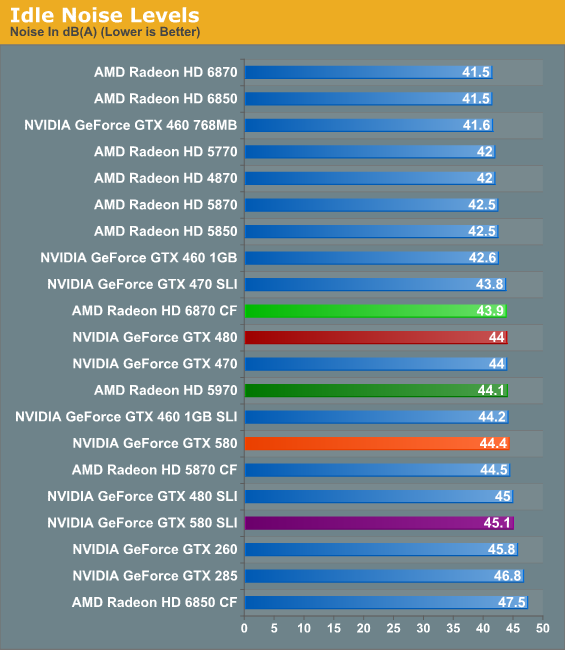
Remember where we said there was a small price to pay for such low idle temperatures? This is it. At 44.4dB, the 580 is ever so slightly (and we do mean slightly) louder than the GTX 480; it also ends up being a bit louder than the 5970 or 6870CF. 44.4 is not by any means loud, but if you want a card that’s whisper silent at idle, the GTX 580 isn’t going to be able to deliver.
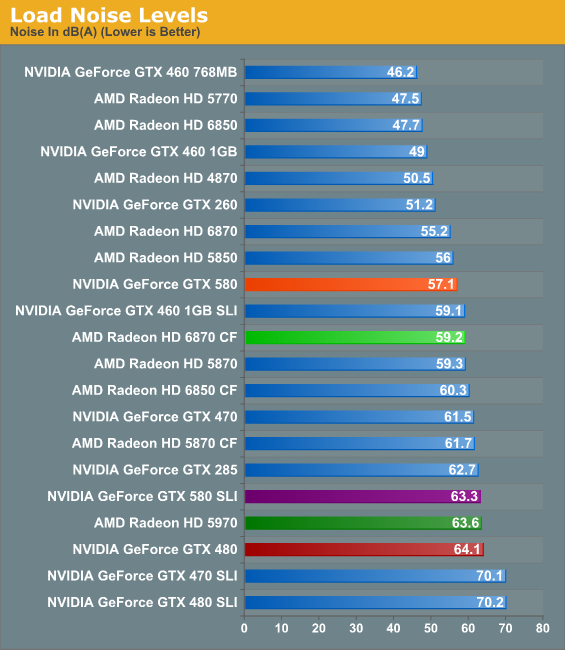
And last but not least is load noise. Between their improvements to power consumption and to cooling, NVIDIA put a lot of effort in to the amount of noise the GTX 580 generates. Where the GTX 480 set new records for a single GPU card, the GTX 580 is quieter than the GTX 285, the GTX 470, and even the Radeon HD 5870. In fact it’s only a dB off of the 5850, a card under most circumstances we’d call the epitome of balance between performance and noise. Graphs alone cannot demonstrate just how much of a difference there is between the GTX 480 and GTX 580 – the GTX 580 is not whisper quiet, but at no point in our testing did it ever get “loud”. It’s a truly remarkable difference; albeit one that comes at the price of pointing out just how lousy the GTX 480 was.
Often the mark of a good card is a balance between power, temperature, and noise, and NVIDIA seems to have finally found their mark. As the GTX 580 is a high end card the power consumption is still high, but it’s no longer the abnormality that was the GTX 480. Meanwhile GPU temperatures have left our self-proclaimed danger zone, and yet at the same time the GTX 580 has become a much quieter card under load than the GTX 480. If you had asked us in what NVIDIA needed to work on with the GTX 480, we would have said noise, temperature, and power consumption in that order; the GTX 580 delivers on just what we would have wanted.










160 Comments
View All Comments
deeps6x - Tuesday, November 9, 2010 - link
Really, who has to have this card when for less money, you can get better results with a pair of 460s in SLI or a pair of 6850s in CF (even better than 460s in almost all cases) to give you better numbers than this card.Take the extra $100+ and bump your CPU up a speed bin or two.
Alberto8793 - Tuesday, November 9, 2010 - link
I will give Nvidia some props they have a very fast card, but interms of performance per dollar, AMD beats them out, go to newegg and click on the 5970 its 499$, go and check the 580, a cool 560$ now return to the anandtech review and check out the benchmarks, they speak for themselves, and finnally load and idle consumption of a two gpu card are lower than a single gpu?!?!?!?!? OUTRAGEOUS!slick121 - Wednesday, November 10, 2010 - link
I mean this is the "enough said!" post. So true, totally agree!ClagMaster - Tuesday, November 9, 2010 - link
Looks like Nvidia has done their homework optimize the GF100 after business pressures to release the GTX-480.Nvidia did a competent makeover of the GF100 and GTX-480 to reduce power, heat and noise.
The GF-110/GTX-580 offers about 10% more performance for the Watts, which are still too high. for my liking.
AnnonymousCoward - Wednesday, November 10, 2010 - link
I think it's more like 30% more performance per watt. Crysis power is 389W vs 421W and averages 15% more fps.the_elvino - Wednesday, November 10, 2010 - link
I would take Anand's power consumtion measurements of 421W for the GTX 480 and 389W for GTX 590 with a few pinches of salt.HardOCP compared the power draw in SLI and recorded following numbers for the entire system under full load:
GTX 480 SLI: 715W
GTX 590 SLI: 700W
Difference per card between 480 and 590: 7,5W!
The 590 is noticeably cooler though.
http://hardocp.com/article/2010/11/09/nvidia_gefor...
7Enigma - Wednesday, November 10, 2010 - link
Why would HardOCP's numbers be any more accurate than Anand's? One is comparing SLI and one is single card. We have no clue the differences in system configuration (individual variances of parts not the part name), not to mention the inherent variability of the cards themselves.I've said it in the 6850 article and before but power consumption numbers (and thus noise/heat) have to be taken with a grain of salt because there is no independent unbiased source giving these cards for review. A really good or poor cherry-picked sample can completely change the impression of a cards efficiency. And since we know NVIDIA ships cards with varying load voltages it is very easy to imagine a situation where one card would be similar in power draw to the 480 while another would show lower thermals.
Anand/Ryan I've said it before and I'll say it again, you have the chance to be a pioneer in the review field by getting independent sources of cards slightly after release. Yes your original review would have to exclude this (or have a caveat that this is what the manufacturer supplied you with).
Decide on a good number (3-5 shouldn't be unreasonable), and purchase these from etailers/locally anonymously. Test them for power/noise/temp and then either sell them on Ebay at slightly reduced cost or even increased price? (Anandtech approved!...touched by Ryan himself!....whatever....you've got a marketing department) :), and/or take one/all and give them away to your loyal readers like the other contests.
Then have a followup article with the comparisons between the "real" cards and the cherry-picked ones from NVIDIA/AMD. Just think how if the manufacturers know that you might call them out on a cherry-picked sample in a follow-up review, they might just try to avoid the bad press and ship one more closely in line with the product line.
Goblerone - Tuesday, November 9, 2010 - link
I'm confused here. In your review of ATI's new 6870, you were comparing against factory overclocked NVIDIA cards but here you are using reference ATI cards.What gives?
AnandThenMan - Wednesday, November 10, 2010 - link
Why even bother asking. It's clear that Anandtech is not about fairness in reviews anymore. Nvidia got special treatment, plain and simple.Just wait until we see Anandtech preview AMD's Brazos with some benches, you will see even more bizarre and head scratching benchmarks. Wait and see.
Sihastru - Wednesday, November 10, 2010 - link
Lol, give it a rest man... and while you're at it tells us about some similarly priced factory overclocked cards that AMD has on the stores shelves and could be used at the time the review was conducted. Relevent models only please, that have the same performance as the GTX580.